
Palm Tree Seed: The Ultimate Guide to Planting, Growing, and Nurturing Your Tropical Palm
Imagine watching a tiny palm tree seed grow into a majestic tropical palm, transforming your space into a lush, green paradise 
In this ultimate guide, we’ll walk you through everything you need to know about palm tree seeds—from planting and germinating to nurturing your young palm into a thriving beauty. Whether you’re a seasoned gardener or a beginner, these expert tips will help you successfully grow your own palm trees and enjoy the tropical vibes they bring. Let’s get started and turn your palm-growing dreams into reality!
Table of Contents
ToggleUnderstanding Palm Tree Seeds: What You Need to Know 
Palm tree seeds are the starting point for growing beautiful tropical palms that can thrive in your garden or indoor space. Whether you’re a seasoned gardener or a beginner, understanding how to handle and plant palm tree seeds is essential for a successful growth journey. Here’s what you need to know to get started:
1. What Are Palm Tree Seeds? 
Palm tree seeds are the reproductive units of palm trees. They come in a variety of shapes and sizes, depending on the species. Typically, palm seeds are either small and round or large and elongated, with a hard outer shell that protects the seed inside. These seeds contain all the genetic material needed to grow a new palm tree.
2. Types of Palm Tree Seeds 
There are hundreds of palm tree species, and their seeds vary significantly. Some of the most common ones include:
- Coconut seeds (Cocos nucifera): Large, hard, and often found on beaches.
- Date palm seeds (Phoenix dactylifera): Oval and relatively small.
- Areca palm seeds (Dypsis lutescens): Smaller, round, and vibrant yellow or orange when mature.
Each seed has its own requirements for germination, which makes choosing the right one crucial for your gardening plans.
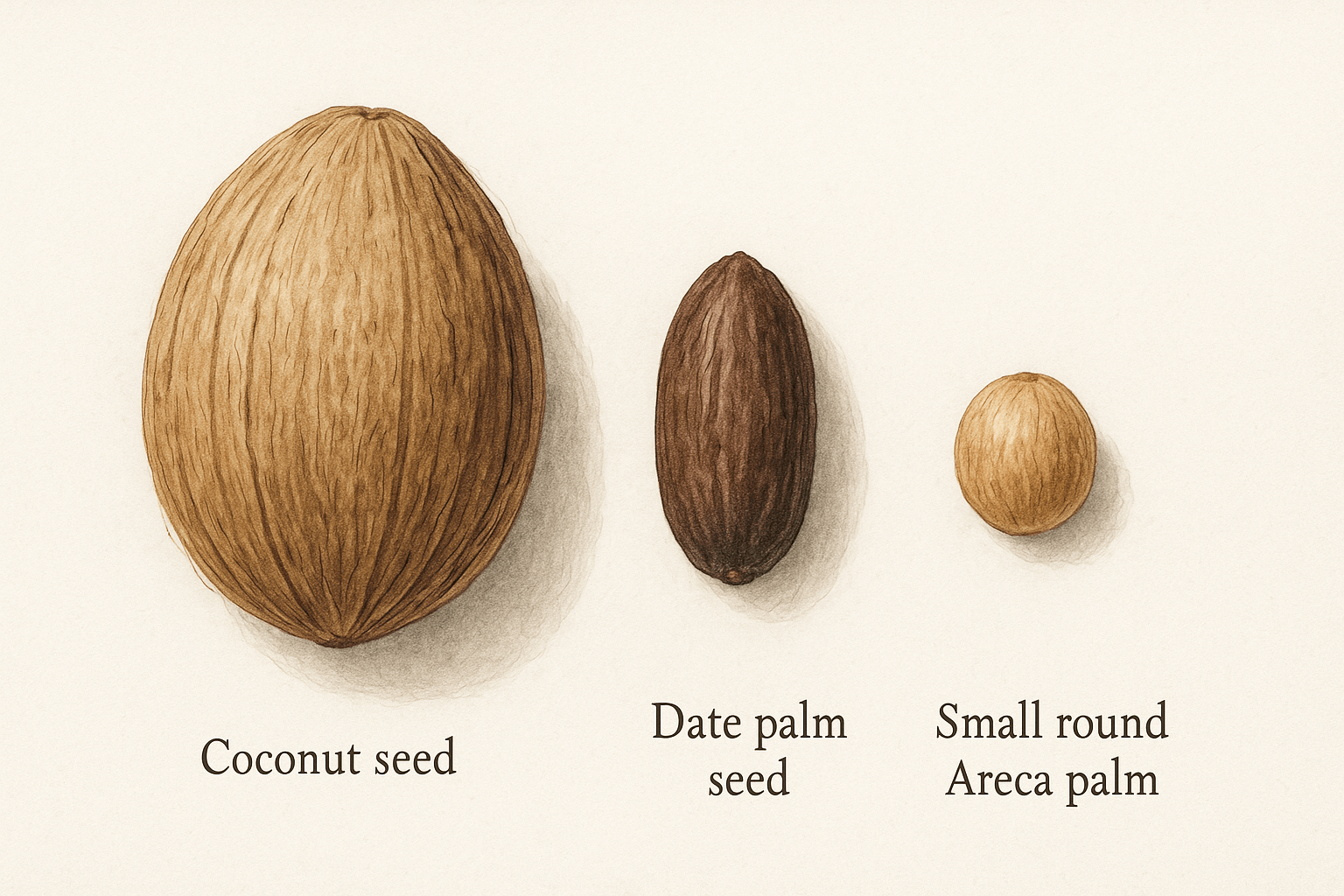
3. How to Collect Palm Tree Seeds 
If you’re collecting seeds from an existing palm tree, wait until the fruit ripens fully. Most palm fruits start off green and turn color as they mature. Once ripe, carefully remove the seeds from the fruit. If purchasing from a nursery or online, ensure you’re buying fresh seeds for the best chance of success.
4. Germinating Palm Tree Seeds 
Palm seeds can be trickier to germinate than other types of seeds, but with the right care, you can succeed. Here’s a simple step-by-step guide:
- Soak the Seeds: Place your seeds in warm water for 24 to 48 hours. This softens the hard outer shell and prepares them for germination.
- Choose a Germination Medium: Use a well-draining seed-starting mix, coconut coir, or sphagnum moss. These mediums retain moisture but don’t allow the seeds to sit in water.
- Plant the Seeds: Plant the seeds in small pots, burying them just below the surface. Keep the soil lightly moist, not soggy.
- Warmth and Light: Palm seeds prefer warm temperatures (70-90°F / 21-32°C) and indirect sunlight. Keep them in a warm, bright spot or use a heat mat for extra warmth.
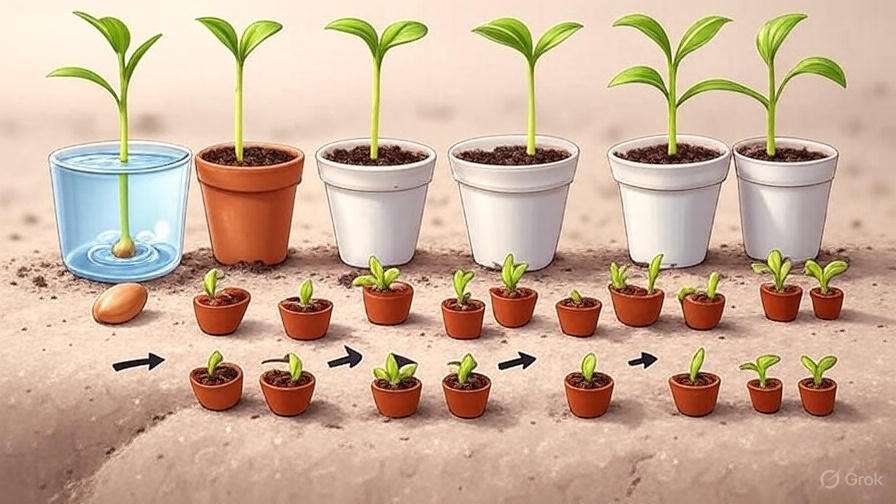
5. How Long Does It Take to Germinate? 
Patience is key. Palm seeds can take anywhere from a few weeks to several months to germinate, depending on the species. Check the seeds regularly, ensuring the soil stays moist and the temperature remains stable. Some species, like the coconut, may take up to 6 months to sprout!
6. Transplanting Your Palm Seedlings 
Once your palm seedling has sprouted and grown strong enough to handle a larger environment (usually after a few months), it’s time to transplant it into a bigger pot or directly into the ground. Be sure to transplant in the early spring or late fall to avoid temperature extremes.
Happy planting!
Choosing the Right Palm Tree Seed 
Choosing the right palm tree seed is essential to growing a healthy and thriving palm in your garden. With so many varieties available, it can be overwhelming to know where to start. But don’t worry! This guide will help you select the best palm tree seed for your space and needs, ensuring a smooth and successful planting process.
1. Know Your Climate 

Before purchasing palm tree seeds, it’s crucial to consider your local climate. Some palms thrive in tropical regions, while others are more suited to subtropical or even cooler climates. Make sure the variety you choose can grow in your region’s temperature and humidity levels.
- Tropical palms (like Coconut Palm or Date Palm) prefer warm, humid conditions.
- Subtropical palms (like Canary Island Date Palm) can tolerate mild winters but need warmth.
- Cold-hardy palms (like Needle Palm or Windmill Palm) are great for cooler areas.
2. Size Matters 
Palm trees come in various sizes, and selecting one that fits your space is key. Smaller palms are perfect for indoor planting or smaller gardens, while larger palms need more room to grow and spread out.
- Small palms (like Parlor Palm or Sago Palm) are ideal for small gardens or containers.
- Medium-sized palms (like Foxtail Palm or Queen Palm) require moderate space.
- Large palms (like Royal Palm or Coconut Palm) are great for spacious gardens or landscapes.

3. Look for Freshness 
Always choose fresh, high-quality seeds. Palm tree seeds can be sensitive to aging, and older seeds might not germinate. When purchasing, look for seeds that are firm, plump, and not dried out.
4. Consider Growth Speed 
Some palms grow quickly, while others are slow-growers. If you’re looking for fast results, choose a variety that germinates and grows quickly. However, keep in mind that fast-growing palms may require more maintenance.
- Fast-growing palms (like the Queen Palm) can provide quicker shade or aesthetics.
- Slow-growers (like the Sago Palm) may take longer but often have a more compact growth habit.
5. Seed Quality and Source 
Always buy from reputable sources, like specialized nurseries or trusted online retailers. High-quality seeds are essential for successful germination, and sourcing from a reliable vendor will ensure you get healthy seeds.
6. Check for Special Care Needs 

Some palm tree varieties require specific care during germination, such as soaking or stratification (cold treatment). Be sure to read the care instructions for the seeds you’re purchasing to ensure you’re prepared to give them the right start.
By taking these factors into account, you can choose the right palm tree seed for your garden and give your palm a strong start in life. Happy planting!
Preparing Palm Tree Seeds for Planting 
Before you plant your palm tree seeds, preparing them properly is crucial for a successful germination process. This step-by-step guide will ensure your seeds have the best start, setting the stage for strong, healthy palms in the future. Let’s dive into the process:
1. Select Fresh, High-Quality Seeds 
The first step is choosing healthy, fresh seeds. Palm seeds lose their viability over time, so look for seeds that are plump, firm, and free from mold or damage. If you’ve collected seeds yourself, make sure they come from a mature and healthy palm tree. Freshness is key to ensuring a high germination rate.
2. Clean the Seeds Thoroughly 
Once you’ve got your seeds, clean them to remove any dirt, pulp, or fruit residue. This helps prevent mold growth and ensures the seed has enough space to breathe. You can use warm water to rinse the seeds, gently scrubbing with your fingers. If needed, soak them in water for 24-48 hours to loosen stubborn residues.
3. Soak the Seeds to Speed Up Germination 
Soaking seeds can significantly speed up germination by softening their outer shell. Fill a container with lukewarm water and place the seeds inside. Let them soak for 24-48 hours, but avoid leaving them too long as excessive soaking can cause rot. After soaking, drain the water and prepare for the next step.
4. Scarify Tough Seed Shells (If Necessary) 
Some palm seeds have hard, thick shells that can hinder water absorption. For these, scarification may be necessary. This involves gently nicking the seed coat with a sharp knife or sandpaper to create a small opening, allowing moisture to penetrate. Be careful not to damage the inner seed. For softer seeds, this step may not be needed.
5. Prepare the Planting Medium 
Palm seeds prefer a well-draining, light soil mix. You can use a combination of potting soil, perlite, and sand for the perfect balance. The goal is to provide an environment that retains moisture without becoming soggy. Fill your pots or seed trays with this mix, ensuring the soil is evenly moist before planting your seeds.
6. Plant the Seeds at the Right Depth 
When planting your seeds, ensure you plant them at the correct depth. Generally, you’ll want to plant them about 1 to 2 times the width of the seed deep into the soil. Planting them too shallow may dry them out, while planting too deep may prevent germination.
7. Keep the Environment Warm and Humid 

Palm seeds thrive in warm, humid conditions. Keep the temperature around 75°F (24°C) and maintain high humidity levels. You can achieve this by covering the seed tray with a clear plastic lid or a plastic wrap, creating a mini greenhouse effect. Make sure to check for condensation, as this indicates the ideal humidity.
8. Monitor and Wait Patiently 
Now that your seeds are planted, patience is key. Depending on the species, palm seeds can take anywhere from a few weeks to several months to germinate. Check the soil regularly to ensure it’s moist but not waterlogged. As soon as you see little green shoots, you know your preparation has paid off!
Key Takeaways:
- Select fresh, healthy seeds for better germination.
- Soak and clean your seeds for optimal conditions.
- Scarify tough seeds to break the hard outer shell.
- Plant in a well-draining, moist medium for best results.
- Maintain warmth and humidity to encourage germination.
By following these steps, you’ll be well on your way to growing a thriving palm tree 
Planting Palm Tree Seeds: A Step-by-Step Guide 
Planting palm tree seeds is an exciting and rewarding way to grow these tropical beauties in your garden or indoors. Whether you’re a seasoned gardener or just starting, this step-by-step guide will ensure you succeed in nurturing your palm tree from seed to sprout. Let’s dive in!
1. Choose the Right Palm Seed 
The first step in planting palm tree seeds is selecting the right variety for your climate. Some palms thrive in tropical conditions, while others do well in temperate zones. Popular choices include:
- Areca Palm: Ideal for indoor planting
- Date Palm: Thrives in warm, dry climates
- Coconut Palm: Perfect for coastal areas
Make sure to research which type of palm is best suited for your environment before purchasing the seeds.
2. Prepare the Seeds 
Palm seeds need to be fresh and viable for successful germination. If you’re using harvested seeds, here’s what you need to do:
- Clean the Seeds: Remove any pulp or surrounding fruit.
- Soak the Seeds: Place seeds in warm water for 24-48 hours to soften the outer shell. This helps speed up germination.
If your seeds are dry or old, germination may take longer, or they may not sprout at all.
3. Choose the Right Planting Container 
For germinating palm seeds, a small pot or seed tray works best. Ensure it has drainage holes to prevent waterlogging, which can lead to seed rot. Fill the container with a well-draining, rich potting mix designed for tropical plants.
4. Plant the Seeds 
Now that your seeds are prepared, it’s time to plant them! Here’s how:
- Planting Depth: Dig a small hole, about 1-2 inches deep. Palm seeds need to be placed on their side for optimal growth.
- Spacing: Leave space between each seed to avoid overcrowding as they begin to sprout.
Cover the seeds gently with soil and water them lightly.
5. Create a Warm, Humid Environment 
Palm seeds need warmth and humidity to sprout successfully. Keep the seed tray in a warm location (around 75-85°F or 24-29°C) and maintain humidity by covering the container with plastic wrap or placing it in a greenhouse.
If you’re growing palms indoors, you can also place the pot in a warm, sunny spot or under grow lights.
6. Watering and Care 
Water the seeds regularly but be careful not to overwater. Keep the soil moist, not soggy. If you notice mold or rot, reduce watering and ensure good air circulation around the seeds.
7. Wait for Germination 
Patience is key! Palm tree seeds can take anywhere from 3 weeks to several months to germinate, depending on the species and environmental conditions. Check the seeds regularly for signs of sprouting, but avoid disturbing them too much.
8. Transplant Your Seedlings 
Once your seeds have germinated and the seedlings are a few inches tall, it’s time to transplant them into larger pots. Use a well-draining potting mix, and make sure the container is big enough for the roots to grow.
If you live in a warm climate, you can also transplant your palm seedlings directly into your garden.
Tips for Success 
- Be patient: Some palm species take longer to sprout than others, so don’t be discouraged if you don’t see growth right away.
- Maintain proper humidity: If your indoor space is dry, use a humidity tray or mist the seedlings regularly to keep the environment moist.
- Monitor the temperature: Keep the soil warm but not too hot to avoid damaging the seeds.
With these steps, you’ll be well on your way to successfully planting and growing your palm tree from seed! 
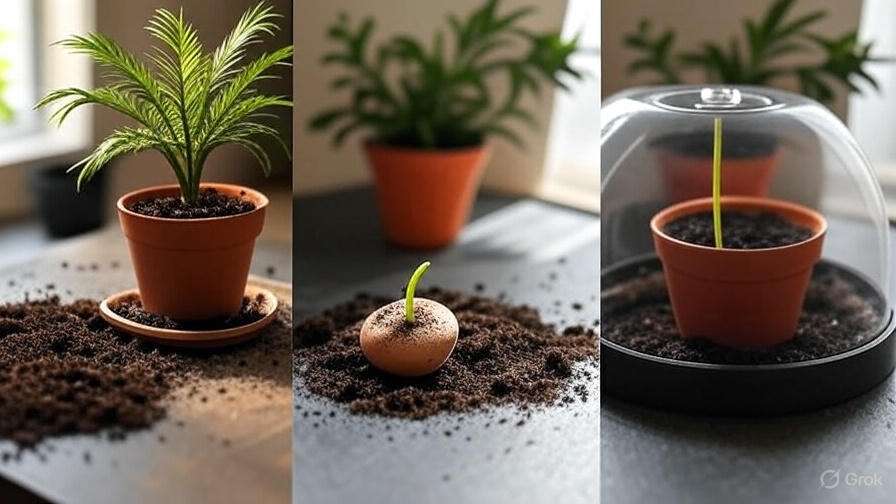
Nurturing Your Growing Palm Tree Seedling
Congratulations on successfully planting your palm tree seedling! 
1. Choosing the Right Spot 
Palm trees love sunlight, so place your seedling in a spot where it can get plenty of indirect light. If you’re growing your palm indoors, find a bright room with access to natural light. If you’re growing it outdoors, make sure it’s in a location that gets at least 6 hours of sunlight each day. Just be mindful of the intense midday sun, which can scorch the tender leaves of young palms.
2. Watering Wisely 
Watering is one of the most crucial aspects of nurturing your palm tree. Young palms need consistent moisture, but they don’t like being waterlogged. Ensure the soil is well-draining to prevent root rot. Water when the top inch of soil feels dry, but always check that the water drains freely from the pot or ground. During hot weather, you may need to water more frequently to keep the soil moist.
3. Feeding Your Palm 
Your palm will benefit from regular feeding, especially during its growing season. Use a balanced, slow-release fertilizer with micronutrients every 4-6 weeks. Palms require extra potassium, magnesium, and other trace elements to thrive, so look for fertilizers specially designed for palms or tropical plants. Avoid over-fertilizing, as it can harm the young plant.
4. Maintaining Ideal Soil Conditions 
Palm seedlings prefer slightly acidic to neutral soil with good drainage. If your soil isn’t naturally suitable, you can improve it by adding organic compost or well-rotted manure. Make sure the pot or planting area has sufficient drainage holes to avoid water pooling at the bottom, which could drown the roots.
5. Humidity and Temperature 
Palm trees thrive in warm, humid conditions, so if you’re growing your seedling indoors, consider increasing humidity. You can place a humidifier near the plant or mist it lightly every few days. Keep your palm at temperatures between 65°F and 85°F (18°C to 29°C) for optimal growth. Avoid placing it near drafts or air conditioning vents, as this can dry it out.
6. Pruning and Trimming 
Although your palm tree seedling doesn’t require much pruning, it’s important to remove any dead or yellowing leaves to encourage healthy growth. Don’t cut off the central growing point, as this can stunt its growth. Use clean, sharp scissors or pruning shears to trim away damaged or excess foliage.
7. Repotting as It Grows 
As your palm tree grows, it will eventually outgrow its pot or planting space. When the roots become cramped, it’s time to repot. Choose a pot that is just slightly larger than the current one to allow for root expansion. Repot your palm every 1-2 years, depending on how quickly it grows. Make sure to gently loosen the root ball before transferring it to the new pot.
8. Patience Is Key 
Remember, palm trees grow slowly, so don’t expect rapid growth. With proper care, your seedling will begin to show signs of growth, such as new fronds or leaves. Be patient and keep providing the right conditions for your palm to thrive.
By following these steps, you’ll set your palm tree on the path to healthy growth and a long life. With the right nurturing, your small seedling will soon transform into a stunning tropical beauty in your home or garden!
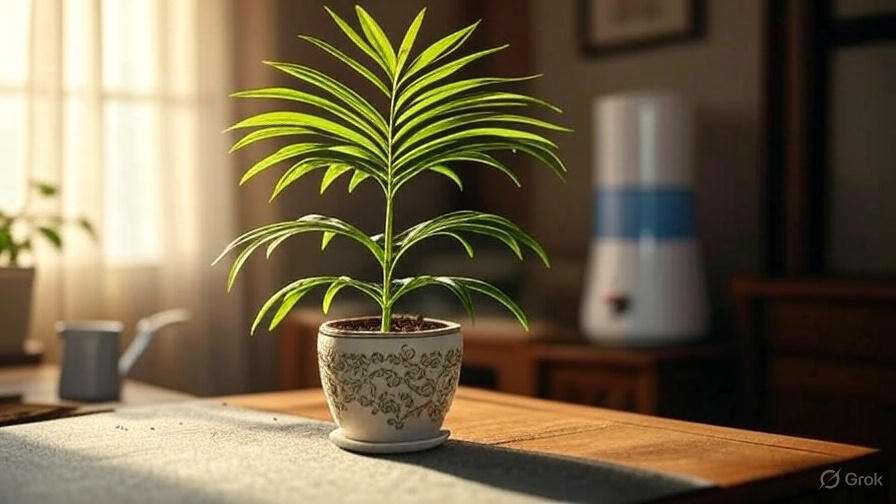
Common Problems When Growing Palm Tree Seeds and How to Fix Them 
Growing palm tree seeds can be an exciting and rewarding process, but it comes with its fair share of challenges. Whether you’re a beginner or an experienced gardener, you’ll likely encounter a few common problems along the way. In this section, we’ll walk you through the most frequent issues and provide simple, effective solutions to ensure your palm tree seeds thrive.
1. Seeds Not Germinating 
One of the most frustrating problems is when your palm seeds refuse to sprout. This can happen for a variety of reasons.
Fix:
- Ensure Fresh Seeds: Old seeds may have lost their viability. Always use fresh seeds for the best chance of germination.
- Soak Seeds: Soaking seeds in warm water for 24–48 hours before planting helps soften the seed coat, encouraging faster germination.
- Right Temperature: Most palm seeds need warmth to germinate. Keep the seeds in a warm, humid environment (around 75°F to 85°F or 24°C to 29°C). A seed heat mat can be very helpful if you’re growing indoors.
2. Seeds Rotting or Molding 
Overwatering or using poorly-draining soil can cause palm seeds to rot or develop mold.
Fix:
- Well-Draining Soil: Use a well-draining potting mix to avoid waterlogging. Consider adding sand or perlite to the soil to improve drainage.
- Watering Schedule: Water the seeds lightly and let the soil dry out between waterings. Ensure the container has drainage holes to allow excess water to escape.
- Airflow: Good airflow around the seeds helps prevent mold. If you’re using a humidity dome, make sure to ventilate it occasionally.
3. Weak Seedlings with Yellowing Leaves 
If your seedlings start to show yellowing leaves or appear weak, they might not be getting the nutrients they need.
Fix:
- Fertilize Gently: Palm trees are sensitive to over-fertilizing. Use a diluted, balanced fertilizer designed for palms, applying it once every 4–6 weeks. Ensure the seedlings are getting the right mix of nitrogen, phosphorus, and potassium.
- Proper Light: Palms need plenty of bright, indirect light. Avoid placing them in direct sunlight, which can scorch their leaves. A grow light can be a great option if you’re growing indoors.
4. Pests Attacking Seedlings 
Pests, such as aphids and spider mites, can harm young palm seedlings by sucking out the nutrients.
Fix:
- Inspect Regularly: Check your seedlings for pests, especially on the undersides of leaves. If you spot any, remove them manually.
- Natural Pest Control: Use a mild soap and water spray to treat the plants. Neem oil is also a natural, safe option that can help manage pests without harming your seedlings.
5. Slow Growth or Stunted Development 
If your palm seeds are growing too slowly or appear stunted, the environment might not be ideal.
Fix:
- Temperature and Humidity: Palm seeds thrive in warm, humid conditions. Ensure your seedlings are kept in a humid space or use a humidity dome to mimic their natural environment.
- Proper Spacing: If your seedlings are overcrowded, they may compete for light, water, and nutrients. Thin out weaker plants to give the stronger ones more room to grow.
6. Transplant Shock When Moving Seedlings 


Transplant shock is a common problem when moving palm tree seedlings from their germination containers to larger pots or outdoor spaces.
Fix:
- Gradual Transition: When transplanting, make sure to acclimate the seedlings to their new environment. Gradually expose them to outdoor conditions if you’re planting them outside.
- Handle With Care: Be gentle when handling the roots to avoid damage. Plant the seedlings at the same depth they were growing in their previous container.
By addressing these common problems and following the solutions above, you’ll be well on your way to successfully growing healthy, thriving palm trees!
Happy gardening!
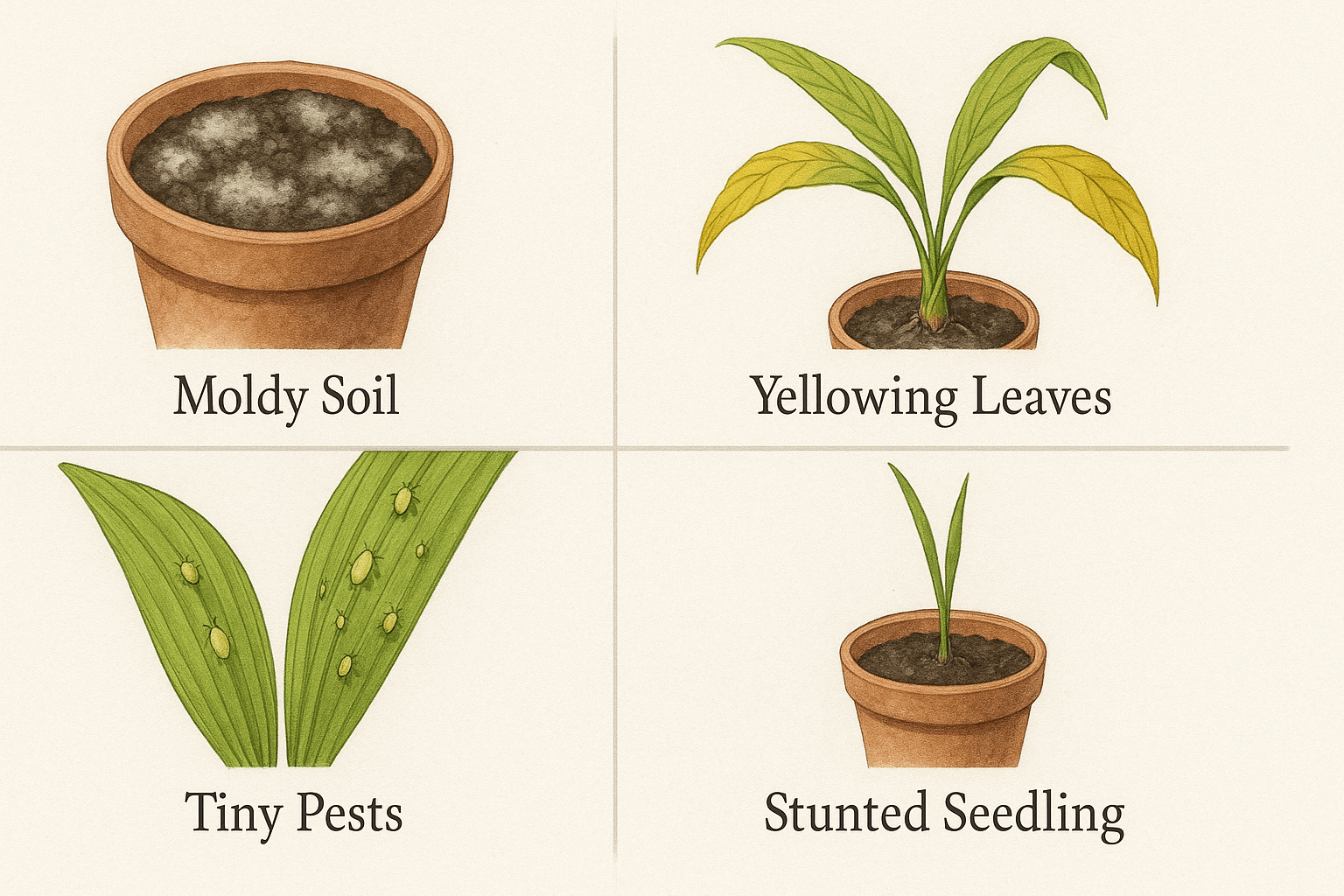
Conclusion

Growing a palm tree from seed is not only a rewarding experience but also an opportunity to bring a piece of the tropics into your home or garden. By following the steps outlined in this guide—from choosing the right seed to providing optimal care and nurturing your seedling—you can watch your palm tree thrive and grow into a beautiful, exotic addition to your space.
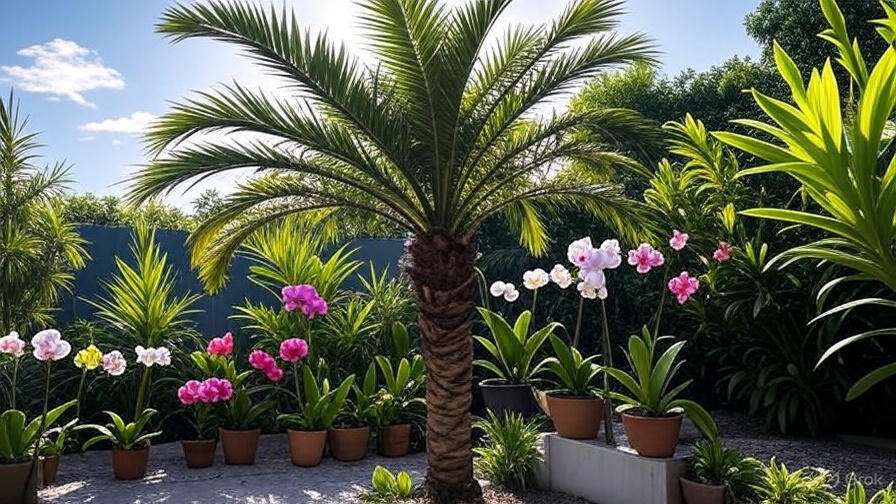
Remember, patience is key. Palm trees can take time to germinate and grow, but with the right care and environment, your efforts will surely pay off. Whether you’re an experienced gardener or a beginner, growing a palm tree from seed can be a fun and fulfilling journey. So, grab your palm tree seeds, start planting, and let the tropical beauty unfold right before your eyes!
Frequently Asked Questions(FAQ)
How long does it take for palm tree seeds to germinate?
Palm tree seeds can take anywhere from 2 weeks to 6 months to germinate, depending on the variety and conditions. Factors like temperature, humidity, and the freshness of the seed can all impact the speed of germination. Patience is key, as some varieties may take longer than others.
Can I grow a palm tree from a seed I collect from fruit?
Yes, you can grow a palm tree from a seed collected from fruit like a date or coconut. However, the seed must be fresh and viable to ensure successful germination. Always clean the seed properly and soak it before planting to enhance germination.
What is the best way to prepare palm tree seeds for planting?
The best way to prepare palm tree seeds is by soaking them in water for 24 to 48 hours to soften the seed coat. Some seeds may require scarification (lightly scratching the surface) to help them germinate more easily. Research your specific palm variety to see if this is necessary.
How deep should I plant my palm tree seeds?
Plant palm tree seeds about 1 to 2 inches deep in the soil. The depth can vary depending on the size of the seed, but it’s generally best to plant them at a shallow depth to allow them to receive enough light and oxygen during germination
Can palm tree seeds grow indoors?
Yes, many palm tree seeds can grow indoors, especially if you provide the right conditions such as indirect sunlight, warmth, and humidity. Indoor palms like the Areca or Parlor Palm thrive in these conditions. Just ensure they get the necessary light and moisture for successful growth.
How often should I water my palm tree seeds?
Keep the soil consistently moist, but not waterlogged. Water your palm tree seeds when the top inch of soil feels dry, and always ensure that your pot has good drainage. Overwatering can cause root rot, so make sure the seed doesn’t sit in stagnant water.
What temperature is best for germinating palm tree seeds?
Palm tree seeds generally require warm temperatures between 70°F and 85°F (21°C to 29°C) for optimal germination. Providing a consistent temperature and maintaining humidity can create the ideal conditions for your seeds to sprout.
What should I do if my palm tree seedling isn’t growing?
If your palm tree seedling isn’t growing, it could be due to factors like insufficient light, improper watering, or nutrient deficiencies. Ensure the seedling is getting the right amount of indirect sunlight, water, and nutrients. If the soil is too dense, consider repotting it in a well-draining mix.

